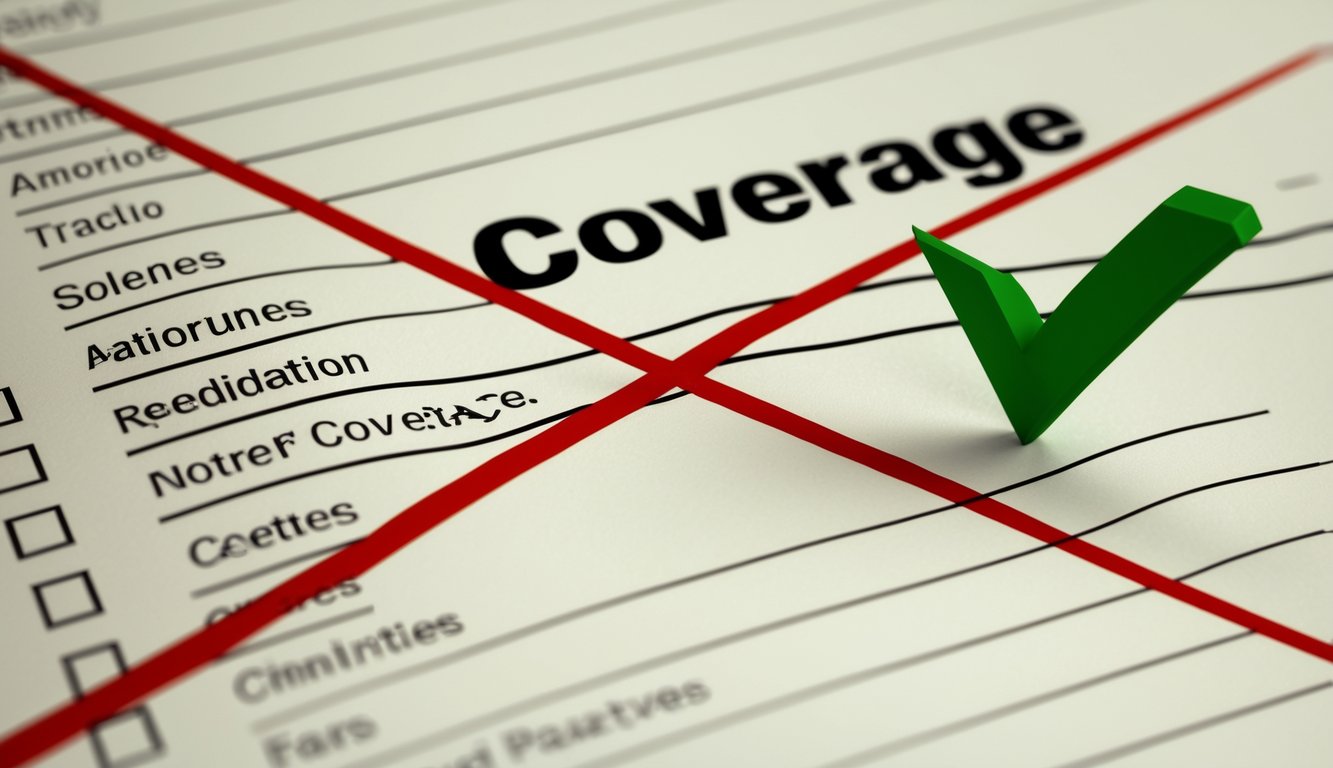Understanding Policy Exclusions
Policy exclusions are critical components of insurance contracts that delineate what is not covered under your insurance policy.
Understanding these exclusions allows you to navigate your coverage more effectively and avoid unexpected gaps that could impact your financial security.
Defining Insurance Exclusions
Insurance exclusions refer to specific provisions within an insurance policy that identify circumstances or events not covered by the policy.
They serve as a key mechanism for insurers to manage risk.
Understanding these exclusions is vital because they define the limits of your coverage.
For instance, certain natural disasters, such as floods or earthquakes, may be excluded from standard homeowners insurance policies.
When examining your policy, familiarize yourself with these terms to ensure you are aware of any limitations on your coverage.
Types of Policy Exclusions
Exclusions can be categorized into various types, each addressing different aspects of risk.
Common categories include:
- General Exclusions: These apply across most policies, such as events occurring due to negligence.
- Specific Exclusions: These are detailed exclusions that address particular risks, such as pre-existing medical conditions in health insurance.
- Conditions for Coverage: Some exclusions may specify conditions under which coverage is voided, such as operating a vehicle without a valid driver’s license.
Recognizing the different types of exclusions helps you better understand the landscape of your insurance coverage and make informed decisions regarding your risk management.
The Role of Exclusions in Risk Management
Exclusions play a significant role in how insurers mitigate risk and protect their financial interests.
By clearly defining what is not covered, insurers can set appropriate premiums and offer more tailored policies.
For you as a policyholder, recognizing the role of exclusions can influence your insurance choices.
Key points to consider:
- Exclusions help in cost management for the insurer, which can lead to lower premiums for you.
- Awareness of exclusions allows you to seek additional coverage for unprotected risks, potentially through endorsements or riders.
Assessing exclusions within your insurance coverage equips you with the knowledge necessary to advocate for the protection that best suits your needs.
Specific Exclusions and Coverage

Understanding specific exclusions is essential for navigating your insurance policies effectively.
Different types of insurance have unique limitations that can significantly impact your coverage in various situations.
Property Exclusions
In homeowners insurance, certain events are often excluded from coverage. Natural disasters like earthquakes and floods typically fall under these exclusions.
If your property is damaged due to an earthquake, your standard policy may not cover the repairs without an additional rider.
Furthermore, many policies exclude damages caused by neglect or poor maintenance.
For instance, if your roof deteriorates due to lack of upkeep, you may find your claim denied.
Be sure to read the fine print regarding coverage limitations, especially when it comes to flood insurance.
Health Insurance Limitations
Health insurance policies often contain exclusions that can leave you unprotected. Pre-existing conditions are commonly excluded or subject to waiting periods.
For example, if you had a health issue before purchasing your policy, related treatments may not be covered.
Additionally, certain elective procedures, like cosmetic surgery, may also be excluded from coverage.
It’s crucial to review the specifics of what your health insurance will not cover.
Pay attention to any stipulations regarding preventive care, as these can affect your benefits.
Automobile Insurance Restrictions
Personal auto insurance policies come with specific exclusions as well.
For example, damages incurred while driving under the influence may not be covered, which can result in significant out-of-pocket costs.
Additionally, your policy might exclude coverage for certain types of vehicles, such as motorcycles or leased cars.
Always check the exclusions related to the use of your vehicle, especially if you plan to use it for ridesharing or commercial purposes.
Understanding these restrictions helps in making informed decisions about your coverage.
Premiums and Additional Coverage Options

Understanding how policy exclusions affect premiums and the additional coverage options available is crucial for effective insurance management.
These elements influence your financial commitment and the extent of protection offered by your policy.
The Impact of Exclusions on Premiums
Exclusions in your policy can directly affect the premiums you pay.
Insurance companies assess risk when determining premiums, and certain exclusions may indicate higher risk levels.
For instance, if your policy excludes coverage for natural disasters, insurers might offer a lower premium because they aren’t liable for those events.
Conversely, if you require coverage in high-risk areas, expect higher premiums due to increased potential claims.
When you compare policies, analyze how exclusions influence the overall cost.
Policies with limited exclusions may have higher premiums, but they offer broader protection, reducing coverage gaps.
Always evaluate the cost against the level of risk you are willing to absorb.
Add-ons and Endorsements
Add-ons, often referred to as endorsements, enable you to customize your policy by covering specific exclusions for an additional premium.
For example, you might consider a rider to include coverage for valuable items not typically covered under standard policies.
Each optional add-on can address unique needs, such as coverage for specific perils like flood or earthquake protection.
When considering endorsements, evaluate their relevance to your risk profile and the additional costs involved.
Understanding these options can help you acquire more comprehensive coverage that suits your individual circumstances.
Purchasing Additional Coverage
Purchasing additional coverage is a proactive approach to mitigate risks associated with exclusions.
If you find significant gaps in your standard policy, exploring supplemental options ensures you have adequate protection.
Begin by discussing your needs with your insurance company.
They can guide you toward suitable policies or endorsements that align with your coverage requirements.
Considerations may include supplementary liability coverage, umbrella policies, or specialized insurance for unique assets.
Before committing, always review the terms, limits, and costs associated with each additional coverage option.
This diligence will help you make informed decisions that enhance your overall protection strategy while managing your financial exposure.
Legal Aspects of Insurance Exclusions

Understanding the legal framework surrounding insurance exclusions is crucial for policyholders.
Knowledge of how exclusions function within insurance contracts can significantly affect your coverage and claims process.
Insurance Contracts and Law
Insurance contracts are governed by specific laws that dictate their formation and enforcement.
These contracts typically include detailed provisions outlining coverage exclusions.
Legally, insurers must clearly state any exclusions in the policy to ensure that you, as the insured, are aware of the limitations.
Exclusions can include various situations such as natural disasters or certain high-risk activities.
Familiarizing yourself with these legal facets will help you navigate any potential ambiguities in your policy.
It’s important to understand that state laws may vary, affecting how exclusions are interpreted and enforced in court.
Claims and Disputes over Exclusions
When a claim is filed, disputes often arise regarding the applicability of certain exclusions.
If an insurer denies a claim based on an exclusion, you have the right to contest that decision.
Understanding the specific language in your policy is vital during this process.
In situations where you believe a claim has been unjustly denied, documentation is key.
Collect all relevant information and policy provisions to support your position.
Legal routes, including mediation or lawsuits, may provide channels for resolving disputes.
Be aware that courts typically uphold insurers’ rights to enforce exclusions, but they must do so in accordance with state laws and contractual obligations.
Common Exclusions in Various Insurance Types

Understanding the common exclusions in different types of insurance can help you make informed choices.
Familiarity with these exclusions aids in better risk management and prepares you for potential liability claims.
Commercial and Business Insurance Specifics
In the realm of commercial and business insurance, specific exclusions can significantly affect coverage.
General liability insurance typically excludes losses arising from employee injuries, which are covered under workers’ compensation.
Professional liability policies often exclude incidents related to criminal acts or fraudulent behavior.
Additionally, many commercial property policies do not cover damage from natural disasters unless a separate rider is purchased.
Other exclusions include:
- Pollution-related issues: Many policies exclude liabilities associated with pollution unless explicitly included.
- Property in transit: Damages occurring while goods are being transported may not be covered.
Awareness of these exclusions is crucial for businesses to ensure adequate protection.
Liabilities and Personal Insurance
Personal insurance policies, including personal auto and life insurance, also come with notable exclusions.
Personal auto insurance typically excludes coverage for vehicles used for commercial purposes, racing activities, or those driven without a valid license.
Life insurance may exclude coverage for suicide within the first two years.
It may also not cover deaths caused by extreme activities like skydiving or bungee jumping.
Key exclusions in personal insurance include:
- Intentional acts: Any loss or damage resulting from deliberate actions is often not covered.
- War or terrorism: Damage or injuries caused in these events may be excluded across various policy types.
What are the three major categories of policy exclusions?
Policy exclusions generally fall into three major categories:
Absolute exclusions exclude all coverage under specific conditions.
Conditional exclusions apply only in certain circumstances.
Relative exclusions focus on particular types of risks.
Understanding these categories helps you evaluate your policy more effectively.






